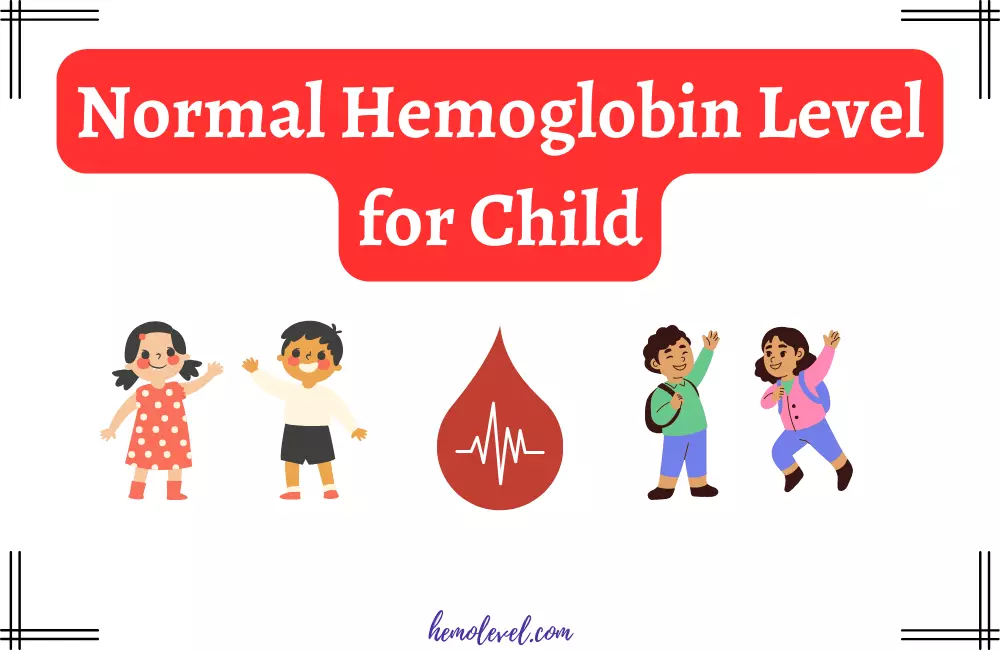Normal Hemoglobin Level for Child
Last updated on December 14th, 2023
Introduction:
In the realm of pediatric health, maintaining optimal hemoglobin levels in children holds paramount importance. Hemoglobin, a protein found in red blood cells, plays a pivotal role in ferrying oxygen from the lungs to various tissues and organs in the body. In this comprehensive guide, we delve into the significance of normal hemoglobin levels for children, exploring the factors influencing these levels and the vital role they play in a child’s growth and development.
What is Hemoglobin and Why Does it Matter?
Hemoglobin, often referred to as the body’s oxygen carrier is a protein that binds with oxygen in the lungs and releases it to cells and tissues throughout the body. This process is vital for energy production and overall bodily functions. In children, whose bodies are in a constant state of growth, maintaining healthy hemoglobin levels is crucial for cognitive development, physical growth, and immune system function.
Normal Hemoglobin Range for Children:
Hemoglobin levels can vary based on age and gender. It’s important to note that these ranges are established to ensure children are receiving adequate oxygen supply for their growing needs. The typical hemoglobin range for children aged 2 to 18 years falls between 11 to 16 grams per deciliter (g/dL). Gender-based variations, if present, are minimal during childhood. As children grow, their hemoglobin levels naturally change, reflecting the changes in their bodies’ oxygen demands.
| Age | Female Range (in g/dl) | Male Range (in g/dl) |
| 0–30 days | 13.4–9.9 | 13.4–9.9 |
| 31-60 days | 10.7–17.1 | 10.7–17.1 |
| 2–3 months | 9.0–14.1 | 9.0–14.1 |
| 3–6 months | 9.5–14.1 | 9.5–14.1 |
| 6–12 months | 11.3–14.1 | 11.3–14.1 |
| 1-5 years | 10.9–15.0 | 10.9–15.0 |
| 5-11 years | 11.9–15.0 | 11.9–15.0 |
| 11-18 years | 11.9–15.0 | 12.7–17.7 |
Factors Influencing Hemoglobin Levels in Children:
- Nutritional Factors: Iron-rich foods are the cornerstone of maintaining healthy hemoglobin levels in children. Incorporating sources like lean meats, beans, leafy greens, and fortified cereals can help prevent anemia, a condition characterized by low hemoglobin levels. Equally essential are vitamins and minerals like vitamin B12, folic acid, and vitamin C, which support hemoglobin production and absorption of iron from food.
- Genetic Factors: Some children may face genetic factors that influence hemoglobin levels. Inherited conditions like thalassemia and sickle cell anemia can lead to abnormal hemoglobin production, affecting oxygen-carrying capacity. Genetic counseling and medical intervention are crucial for managing these conditions and maintaining optimal hemoglobin levels.
- Environmental Factors: The environment a child lives in can also impact their hemoglobin levels. For instance, children residing at high altitudes may develop slightly elevated hemoglobin levels over time due to the body’s adaptive response to lower oxygen levels. Other external factors, such as exposure to pollutants and toxins, can potentially affect hemoglobin production and function.
- Detecting and Diagnosing Abnormal Hemoglobin Levels: Recognizing symptoms of low hemoglobin levels is vital for early intervention. Fatigue, pale skin, and shortness of breath can indicate anemia. Accurate assessment involves diagnostic tests like a complete blood count (CBC), which measures hemoglobin levels and identifies abnormalities. Regular visits to healthcare professionals ensure timely monitoring and appropriate intervention if needed.
The Role of Healthy Hemoglobin Levels in Child Development:
- Cognitive Development and School Performance: Optimal hemoglobin levels play a role in supporting cognitive functions and academic performance. A well-oxygenated brain facilitates better children’s concentration, memory, and overall cognitive development.
- Physical Growth and Stamina: An adequate oxygen supply is essential for physical growth and maintaining stamina. Children with healthy hemoglobin levels have the energy to engage in physical activities, which are crucial for their musculoskeletal development.
- Preventing Anemia-Related Complications: By maintaining optimal hemoglobin levels, children are less likely to experience complications related to anemia, such as weakened immune function and delayed growth.
Promoting Healthy Hemoglobin Levels in Children:
- Balanced Diet Recommendations: Incorporating iron-rich foods, such as red meat, poultry, fish, and leafy greens, is pivotal. Additionally, offering foods rich in vitamin C enhances iron absorption.
- Iron Supplementation When Necessary: In cases where dietary sources aren’t sufficient, healthcare providers may recommend iron supplements. These should only be taken under medical supervision.
- Lifestyle Practices for Optimal Hemoglobin: Encouraging physical activity and minimizing factors that hinder iron absorption, like excessive caffeine consumption during meals, can contribute to maintaining healthy hemoglobin levels.
- When to Consult a Pediatrician: Recognizing when to seek medical attention is crucial. If a child displays symptoms of anemia or if there are concerns about their development, consulting a pediatrician is advisable. Regular check-ups allow for continuous monitoring of hemoglobin levels and overall health.
Conclusion:
Understanding and maintaining normal hemoglobin levels is a cornerstone of pediatric health. Adequate oxygen transport ensures a child’s physical growth, cognitive development, and overall well-being. By focusing on nutrition, genetics, and environmental factors, parents and caregivers can actively contribute to their children’s optimal hemoglobin levels. Regular medical check-ups and early intervention, when necessary, ensure that children thrive with healthy hemoglobin levels, setting the stage for a bright and vibrant future.
Also Read:
- Most Common Questions on Hemoglobin Levels

- Myths about increasing Hemoglobin Levels

- Treatment for High Hemoglobin Levels: How to Lower Your Levels Safely

To know more about Hemoglobin Levels, visit Hemolevel.com
